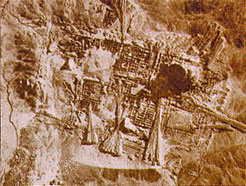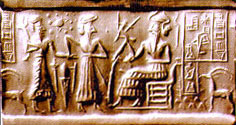|

by Steve Quayle
from
SteveQuayle Website
Recently, UFO Magazine attended a
seminar held in Los Angeles, conducted by noted Orientalist and
Biblical scholar Zecharia Sitchin. The seminar came upon the
heels of the publication of the authorís ninth book in his "Earth
Chronicles" series,
The Lost Book Of Enki: Memoirs and
Prophecies of an Extraterrestrial God. If you are not familiar with
Sitchin, you may wonder who he is-and who "Enki" is,
and why tens of thousands of Sitchin fans are excited. In short,
Sitchin is a name synonymous with uncovering humanityís hidden
history. With that in mind, the following will bring you up to
date.
In 1976 a rather amazing book was published. To call up an overripe
metaphor, a small stone was thrown into the middle of a pond, and
the ripples traveled far and wide. As time wore on, the implications
of the book became apparent to a wider audience, and the
author/scholar continued to expand his works.
The book was The 12th Planet, and it was but a harbinger
of the extensive Sitchin studies to come. Close on the heels
of the first book, Sitchin wrote
The
Stairway to Heaven,
followed by
The Wars of Gods and Men,
The Lost Realms,
Genesis
Revisited, Divine Encounters,
The Cosmic Code, and now,
The
Lost Book Of Enki.
|
 |
|
In explaining
ancient beliefs, author Zecharia Sitchin says the Sumerians
made an important distinction between fate and destiny. |
|
 |
What is it that Sitchin maintains,
and why has his massive work been translated into over 70 languages?
And why does Sitchin make the mainstream scientific
establishment so "antsy and shrill" in claiming his work has no
credence?
In this voluminous body of work, Sitchin has laid out a major
revision concerning all of human history. His research is even more
impressive when one realizes that Sitchin is one of only about 200
scholars who can read and translate the ancient Sumerian language.
(An interesting point is that his translations have never been
refuted, only his conclusions.)
According to Sitchinís interpretation of ancient manuscripts, about
430,000 years ago Earth was visited by extraterrestrials who
came here to mine minerals and metals that were needed for their
survival. These extraterrestrials came from an
as-yet-undiscovered planet in our solar system, the
planet Nibiru, which has, says Sitchin, a
3,600-Earth-year orbit. Nibiru, the name bestowed by the ancients,
means "Planet of the Crossing." These extraterrestrials,
according to the ancient Sumerian texts, genetically altered the
indigenous species of early humans and bequeathed all the arts of
civilization to them, such as government, astronomy,
mathematics, animal husbandry and agriculture.
This version of early man was derived not from Sitchinís
imagination, but from what the Sumerians and other ancient peoples
stated in their writings, often from first-hand interaction with
these "gods." Of course, "mainstream" scientists do
not look kindly upon such literal interpretations. When they engage
in attempts to debunk such information, they are loath to own up to
their mis- and disinformation. (See
sidebar below)
Such a predictable lack of accountability from respected members of
the science community cannot lessen the impact of Sitchinís
conclusions. In The Lost Book of Enki, Sitchin relays
the words of one of the chief Anunnaki, the Lord Enki.
While not translated directly from some of the 8,000 sources that
Sitchin claims to have utilized in compiling what he believes would
have been the message of this ET lord, the prose-poem work relies on
his intuitive grasp of the meaning behind Enki-related records.
Sitchin says heís been gathering material on
the Annunaki since the beginning of
his research over 30 years ago.
"I would sit and close my eyes and
try to think, what does it mean when these divine beings say,
íLet us . . . create humans.í Each text makes the other texts
plausible."
|

Photo: This 1926
aerial photo documents excavations of the Sumerian capital
of Ur. The fan-shaped areas are dumps of excavated earth. |
Within those texts, the Holy Bibleís
story of Genesis repeats the story of Enki. But he was
not alone in the task of setting up a new Earthly species.
Sitchin says that Enki worked with his half-brother
Enlil, who shared responsibility for the Earth mission. The
Lost Book takes a "behind the scenes" look at the Anunnaki,
their motivations, ambitions and their reasons for traveling to
Earth and creating the first worker.
According to historians and archaeologists, the Sumerian
civilization collapsed in 2024 BCE. Of this there is no dispute.
According to a study by Harvey Weiss and Timothy Wieskel
of Harvard University and H.M. Cullen from Lamont-Doherty
Earth Observatory at Columbia University, Sumeriaís sudden demise
resulted from an abrupt and unexplained climate change, which
brought aridity and wind-blown dust storms. Their conclusion is
backed up by radiocarbon datings, which indicate this occurred 4,025
years ago, plus or minus 125 years. This computes to the demise
of Sumer in 2024 BCE, a date that Zecharia Sitchin
already established.
|

Photo: The
likely representation of our own solar system-with the extra
planet Nibiru-can be seen toward the upper left of this
4,500-year-old Mesopotamian cylinder seal |
Does Zecharia Sitchinís "Earth
Chronicles" series address the fall of ancient Mesopotamia? Yes,
and more. One ancient text, "Erra Epos," details an age of
conflict between the Lord Marduk (son of the Lord Enki)
and other Anunnaki, over Mardukís bid to become supreme ruler over
Earth. This escalating conflict finally ended when the senior
Anunnaki authorized the use of "weapons of terror" to defeat
what was seen as a threat by Marduk to overrun all known lands. Of
course the question begs to be asked, what were these weapons of
terror? According to Sitchin, the Anunnaki authorized
the use of "nuclear
weapons," the effects of which are still visible today.
The use of these weapons is described in
Sitchinís newest offering. Lord Enki was opposed to their
use, and thought that he alone knew where the weaponsí ancient
hiding place was located. But his brother, Lord Enlil, also
knew where they were hidden, and it was Enlil who gave the
instructions to his son Ninurta on how to "awaken" the
weapons. Upon retrieving the weapons, Ninurta and Enkiís son
Nergal awaited the signal from Enlil. Seven days later, they
received it and set out on their mission of massive destruction.
As the book recites:
|
"I shall kill the son, I
will annihilate the father! Nergal with vengeance was
shouting.
The lands they covet will vanish, the sinning cities I
will upheaval! So did Nergal enraged announce.
Valiant Nergal, will you the righteous with the
unrighteous destroy? So did Ninurta his comrade ask.
The instructions of Enlil are
clear! To the selected targets the way I will lead, you behind me
will follow! The decision of the Anunnaki to me is known! Nergal to
Ninurta, said.
For seven days and seven nights the signal from Enlil the two
awaited. As was his intention, when his waiting was completed,
Marduk to Babili returned.
In the presence of his followers, with weapons armed, his supremacy
he declared; A thousand and seven hundred and thirty-six was the
count of Earth years then.
On that day, on that fateful day, Enlil to Ninurta the signal sent;
To Mount Mashu Ninurta departed, behind him Nergal followed.
The Mount and the plain, in the heart of the Fourth Region,
Ninurta from the skies surveyed. With a squeezing in his heart,
to Nergal a sign he gave: Keep off to him he signaled. Then the
first terror weapon from the skies Ninurta let loose; The top of
Mount Mashu with a flash it sliced off, the mountís innards in
an instant it melted.
Above the Place of the Celestial Chariots the second
weapon he unleashed, With a brilliance of seven suns the plainís
rocks into a gushing wound were made, The Earth shook and crumbled,
the heavens after the brilliance were darkened; With burnt and
crushed stones was the plain of the chariots covered, Of all the
forests that the plain had surrounded, only tree stems were left
standing.
It is done! Ninurta from the skyship, his Black Divine Bird,
words shouted.
The control that Marduk and Nabu so coveted, of it
they are forever deprived!
Then to emulate Ninurta Nergal desired, to be Erra the
Annihilator his heart him urged; Following the Kingís Highway, to
the verdant valley of the five cities he flew.
In the verdant valley where Nabu the people was converting,
Nergal as a caged bird to squash him planned!
Over the five cities, one after the other, Erra upon each
from the skies a terror weapon sent, The five cities of the valley
he finished off, to desolation they were overturned.
With fire and brimstones were they upheavaled, all that lived there
to vapor was turned.
By the awesome weapons were mountains toppled, where the sea waters
were barred the bolt broke open, Down into the valley the seaís
waters poured, by the waters was the valley flooded; When upon the
citiesí ashes the waters poured, steam to the heavens was rising.
It is done! Erra in his skyship shouted. In Nergalís heart
there was no more vengeance.
Surveying their evil handiwork, the two heroes by what they saw were
puzzled: By a darkening of the skies were the brilliances followed,
then a storm to blow began.
Swirling within a dark cloud, gloom from the skies an Evil Wind
carried, As the day wore on, the Sun on the horizon with darkness it
obliterated, At nighttime a dreaded brilliance skirted its edges,
the Moon at its rising it made disappear.
When dawn the next morning came, from the west, from the Upper Sea,
a stormwind began blowing, The dark-brown cloud eastward it
directed, toward the settled lands did the cloud spread; Wherever it
reached, death to all that lives mercilessly it delivered; From the
Valley of No Pity, by the brilliances spawned, toward
Shumer the death was carried.
To Enlil and Enki Ninurta and Nergal the alarm sounded: Unstoppable
the Evil Wind death to all delivers!
The alarm Enlil and Enki to the gods of Shumer transmitted: Escape!
Escape! to them all they cried out. Let the people disperse, let the
people hide!
From their cities the gods did flee, like frightened birds from
their nests escaping they were.
The people of the lands by the Evil Stormís hand were
clutched; futile was the running.
Stealthy was the death, like a ghost the fields and cities it
attacked; The highest walls, the thickest walls, like floodwaters it
passed, No door could shut it out, no bolt could turn it back.
Those who behind locked doors hid inside their houses like flies
were felled, Those who to the streets fled, in the streets were
their corpses piled up.
Cough and phlegm the chests filled, the mouths with spittle and foam
filled up; As the Evil Wind the people unseen engulfed, their
mouths were drenched with blood.
Slowly over the lands the Evil Wind blew, from west to east
over plains and mountains it traveled; Everything that lived, behind
it was dead and dying, people and cattle, all alike perished.
The waters were poisoned, in the fields all vegetation withered.
From Eridu in the south to Sippar in the north did the
Evil Wind the land overwhelm; Babili, where Marduk
supremacy declared, by the Evil Wind was spared."
|
Mankind suffered a devastating blow, an
ancient and lofty civilization was destroyed, and if one believes
the ancient texts as translated by Sitchin, humans 4,000
years ago were exposed to the very same weapons we so fear today.
There can be little doubt that this description mirrors nuclear
devastation. But what about
the Anunnaki? They apparently
remained.
After the destruction of Sumeria, what became of the "state
religions"? The gods apparently migrated, sometimes arising
under other names. They can be found in the religion of the
Hittites, the Indus Valley, Egypt, Babylonia,
the Elamites, Canaanites and the Phoenicians.
Later, as civilizations arose in Greece and the Mediterranean
islands, the godsí influence found its way into those temples and
religion. For example, the Lord Marduk in Egypt is
worshiped as the God "Ra," the Goddess Ishtar is
the Sumerian Goddess Inanna, and so forth.
Sitchin has also found and documented Sumerian influence in
the gods historically revered by cultures in Central and
South America. The Olmecs of Central America have always
been a mysterious civilization. Obviously African peoples, they have
been traced back to about 3,000 BCE. The great Mesoamerican deity,
the "Winged Serpent," or Quetzalcoatl, has been
linked to the Egyptian God Thoth, who was thrown out of
Egypt circa 3,000 BCE. Thoth bore another name from the
Sumerian pantheon, Ningishzidda.
These repetitive appearances of similar deities have carried over
from pre-biblical and biblical times. The question today is this:
where are the Anunnaki now?
SIDEBAR
CAUGHT! BUT SITCHEN SKEPTIC DOESNíT REPENT
UFO The Science and Phenomena Magazine
Volume 17, Number 2, April/May 2002
pages 34 - 37
Dr. E.C. Krupp, director of
the Griffith Observatory in Los Angeles, wrote an article for
the April, 2000 issue of Sky & Telescope magazine, entitled "Lost
Worlds." In it, Krupp mentions Sitchinís book The
12th Planet. In that seminal work, there is an illustration
of a clay tablet made from a "cylinder seal" that shows a star
surrounded by 11 bodies in what appear to be orbits. According
to Sitchin, the ancient Sumerians were aware of our
entire solar system, including the "extra" planet of Nibiru,
because of information given to them by the Anunnaki, or "Those
who from Heaven to Earth came." Krupp refused to allow for that
explanation and suggested that the "star" could have been the
planet Jupiter, of which the ancients were, of course, aware.
In regard to the 11 bodies surrounding the "star,"
Krupp states, "Zecharia Sitchinís books are about ancient
space colonists from a lost í12th planetí that once violently
invaded our solar system." He goes on to say, "credulous readers
are persuaded by Sitchin that the traditions of ancient
Sumer validate this unorthodox reconstruction of solar system
history." In a sidebar, Krupp states, "Sitchinís case
originates in an Akkadian cylinder seal from the third
millennium BC, a portion of [which] features a six-pointed star
surrounded by 11 dots of varying size. Sitchin judged that the
star symbolizes the Sun and the smaller elements are supposedly
planets, including the lost 12th world."
Krupp then suggested that the cylinder seal actually
shows the constellation of Sagittarius (the "Teapot of
Sagittarius"). "And so," Krupp sums up, "if the central object
is not the Sun but Jupiter (with which the ancients were
familiar), and the surrounding objects not planets but the stars
of Sagittarius (with which the ancients were familiar),
Sitchinís extraterrestrials and Nibiru are not needed." In other
words, silly reader, ETs simply will not do!
When Sitchin read Kruppís explanation of the
4,500-year-old Mesopotamian cylinder seal, he began an in-depth
investigation. What he discovered (and by default, Krupp
should have immediately known) is that Jupiter moves in an
ecliptic orbit around the Sun, and could not dip the 11 or 12
degrees south necessary to appear in the "Teapot."
Upon rechecking his information, Sitchin attempted to
contact Sky & Telescope so they could correct Kruppís
error. After writing several letters to the magazine,
without a response, he then sent the magazine several faxes.
Sky & Telescope never did reply to the letters and faxes,
but in August of 2000 Sitchin did receive a two-page
letter from Krupp, written on Griffith Observatory
stationery. In his letter Dr. Krupp stated,
"It is a delight to hear from
you. I have all of your books, have read most of them, and
have listened to you on the radio a couple of times. I have
of course dedicated thought to the arguments you have
developed. Although your handling of the data has inspired
my skepticism, please let me acknowledge the courtesy and
logic of your complaint about the way I evaluated your
Twelfth Planet notions in my monthly column on astronomy and
culture in Sky & Telescope."
Kruppís gracious, but carefully
worded reply made no outright admission of error, but did offer
the following concession:
"You are correct to point out
that I was hasty in offering Sagittarius as an option for
the imagery on the Akkadian cylinder seal VA/243. Certainly
we cannot regard the figure as an accurate map of the Teapot
with Jupiter brewing inside. If youíll allow me Saturn, we
get a little closer, but you are right-no tea-caddied
planet. My caption highlights Jupiter, positions it within
Sagittarius, and suggests a real mapping. Your objection is
sustained."
Still, Krupp went on to
suggest that the object could "possibly" still be "Saturn or
Sagittarius, Leo or Regulus, or possibly Cancer," but he refused
to consider the simplest explanation: that the figures on the
seal were meant to represent our own solar system.
Sitchin wrote Krupp back and offered to "engage in a dialogue,"
but Krupp never bothered to respond. Sky & Telescope
refused to print any letters to the editor from Sitchin
admitting their error, and I am sure simply hoped the problem
would go away.
-D.E.
|




